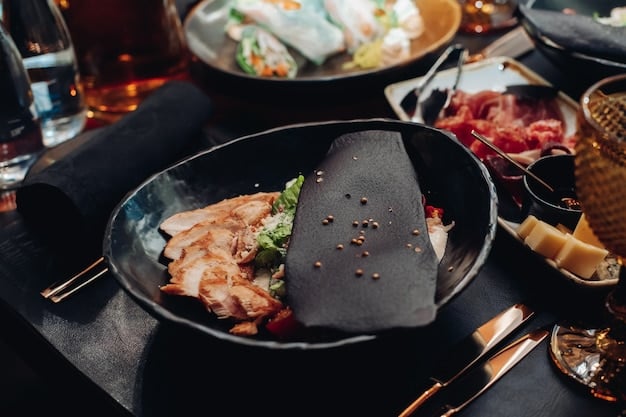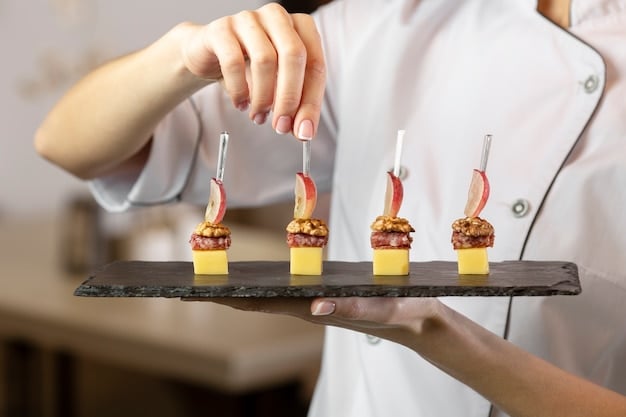Restaurant owners know the pain of watching potential customers walk by. In 2025, the culinary industry has changed dramatically. Customers seek culinary experiences, not just meals. Food must tell stories, cross borders, and create memories—all while tantalizing taste buds with unforgettable flavors.
Fusion cuisine sits at the center of this evolution. It’s not just a passing trend; it’s reshaping how successful Asian fusion restaurants and other eateries operate. When Chinese cuisine meets Indian spices in a dish like Indian pizza, or when French techniques refine Japanese sushi ingredients, something magical happens. New flavors emerge that defy traditional categorization, blending various cuisines into innovative dishes.
What does this mean for your restaurant? Opportunity. While established spots struggle with rigid culinary traditions, you can embrace ingredient fusion to entice curious diners. A fusion menu allows you to incorporate early fusion cuisine inspirations, from Hakka noodles to taco pizza, blending different culinary traditions with modern-style fusion.
The beauty of fusion food lies in its flexibility. You don’t need to overhaul your entire menu—strategic fusion recipes can transform your restaurant’s identity while respecting its roots. Whether experimenting with rice flour in a new dish, using cream cheese in unexpected ways, or applying technique fusion in your cooking, a thoughtful menu design is key.
This guide will show you how fusion cuisine can:
Dramatically increase your customer base by appealing to diverse cultures
Create innovative dishes that get shared on social media
Help you stand out in a crowded market with new dishes inspired by various cooking techniques
Boost profit margins through intentional blend strategies in street food and fine dining
But fusion cuisine isn’t something to approach carelessly. The line between bold innovation and confusing execution is thin. Let’s explore how to use this powerful culinary world approach to transform your restaurant in 2025.
Metrobi drivers are rated 4.97/5
Trusted by local businesses for:
- Background-checked professionals
- Specialized in business deliveries
- Same drivers for consistency
- 4.97/5 average delivery rating
What is Fusion Food? Understanding Fusion Cooking
Combines culinary traditions from different parts of the world.
Creates new flavors by merging distinct ingredients and techniques.
Popular for its innovative and diverse taste experiences.
Definition and Key Features of Fusion Restaurants
Fusion food blends diverse culinary traditions. It involves combining cooking methods, ingredients, or dishes from different cultures to produce something novel. This concept emerged as a result of globalization, with chefs gaining exposure to worldwide cuisines and experimenting with their local dishes. The aim is to produce an exciting yet harmonious combination that offers something unique compared to traditional dishes.
Key features include a creative use of ingredients and an understanding of distinct cooking techniques. For example, mixing spicy Asian spices with Italian pasta or using Mexican chilies in French soufflés. The focus is on balance — ensuring that flavors and textures complement rather than overshadow each other. The result is a dish that may surprise patrons, while still respecting the culinary origins of its components.
Examples of Fusion Food
Some common fusion food examples include sushi burritos and kimchi tacos. Sushi burritos merge the concept of Japanese sushi with the portable, hand-held nature of a burrito, resulting in a meal that’s appealing and convenient. Kimchi tacos combine Korean fermented vegetables with traditional Mexican tacos, offering a burst of flavor that showcases the best of both worlds.
The success of fusion dishes relies heavily on balance. It’s important for chefs to ensure that flavors do not compete or overpower each other. For instance, adding too much kimchi to a taco can overpower the dish, while the right amount can elevate it to new heights of flavor. This balancing act requires a keen understanding of both the ingredients and the traditional recipes from which they originate.
Types of Fusion Food
Fusion foods can be categorized in various ways, often based on technique or cultural inspiration. In some cases, fusion refers to the incorporation of cooking methods from one culture into another’s traditional dishes. For instance, incorporating stir-frying techniques into Italian dishes can produce new, healthier versions of classic recipes.
Alternatively, fusion can be inspired by the ingredients used, such as including exotic spices in familiar dishes. This can lead to new taste experiences and can attract culinary adventurers. For example, using Middle Eastern spices in a traditional British pie can create a dish that feels familiar yet new and appealing. These combinations keep the diners guessing and wanting to explore more of the menu.
Global Fusion Cuisine
On a global scale, fusion cuisine brings flavors from different continents together in exciting ways. A popular example is Italian-Asian pasta, where Eastern ingredients like miso or seaweed infuse traditional Italian dishes. This trend shows how chefs are crafting meals that take the best elements from each culture to make something new that can appeal to a worldwide audience.
Global fusion encourages creativity and challenges traditional notions of what cuisine should be. By bringing together different tastes and techniques, chefs can cater to diverse palate preferences in a single dish. This approach invites chefs to think beyond borders and blend culinary traditions for innovative dining. It often results in dishes that gain worldwide popularity for their unique taste and inventive approach to familiar themes.
Regional Fusion Cuisine: American Sushi and Beyond
Regional fusion cuisine focuses on blending local food cultures that are geographically close or have historical interactions. Well-known examples include Tex-Mex, which fuses American Texan and Mexican cuisines, using Mexican staples like peppers alongside Texan barbecue techniques. Another example is Franco-Vietnamese cuisine, which emerged in Vietnam during French colonial rule and still influences restaurants in both regions to this day.
Regional fusion naturally occurs over time as cultures intermingle, borrow from one another, and adopt new tastes. By combining elements from neighboring countries, chefs can create dishes that feel like natural extensions of local culinary traditions. This approach respects regional ingredients and local tastes while also introducing diners to new experiences that are still connected to their cultural roots.

Benefits of Fusion Food
Unique menu offerings that attract diners.
Wider customer reach, connecting diverse backgrounds.
Culinary innovation that creates buzz and differentiation.
Expands Menu Variety
Fusion food offers a range of unique dishes, creating a distinctive identity for restaurants. This differentiation can lead to increased customer curiosity and engagement. Think about how a restaurant that offers pumpkin spice ramen, or Thai green curry pizza stands out. Fusion food allows for the combination of novel ingredients and flavors that traditional menus may not offer. This blend can set a restaurant apart by offering customers something unexpected.
Offering creative dishes can have practical benefits as well. Expanding a menu with fusion food can mitigate the risks associated with seasonal ingredients and local product availability. Variations on standby favorites from established cuisine could reduce food waste, as they allow for substitution depending on ingredient availability. By strategically planning the introduction of fusion dishes, restaurants can ensure that they maintain the appeal to their regulars while also attracting new diners seeking an adventurous dining experience.
Broadens Customer Base
Fusion cuisine has enormous potential to broaden a restaurant’s customer base. It has innate appeal for food enthusiasts and those searching for new dining experiences. People interested in diverse culinary traditions are often drawn to the innovative combinations found in fusion food. Restaurants offering fusion dishes can attract a demographic of diners eager to explore culinary diversity, from global citizens to those wanting to experience flavors from different cultures without traveling.
Adventurous Diners: 27% of Asian consumers aged 25–34 are seeking adventurous dining experiences, including fusion cuisine.
Fusion cuisine fosters inclusivity and can serve as a bridge across cultural lines. For instance, Korean-Mexican fusion has made its mark through popular food trucks and enthusiastic reviews. This blending of culinary traditions not only appeals to fans of both cuisines, but also generates interest from diners curious about the results of such creative mingling.
Global Food Interest: One-third of U.S. consumers wanted to try new global foods and flavors in 2021, a trend that continued into 2022.
Fusion food’s importance extends beyond menu enhancement. It plays a role in enriching society by fostering cultural exchange and dialogue. As people explore fusion dishes, they often gain familiarity with the histories, ingredients, and traditions of various cultures—encouraging mutual respect and understanding. While some traditionalists might argue that fusion food dilutes cultural authenticity, others believe it innovates and evolves cuisine to reflect contemporary globalized societies.
Customer Attraction Through Fusion Dishes
Memorable dining experiences boost loyalty.
Local flavors engage communities.
1. Creating Unique Dining Experiences
Fusion cuisine offers diners a one-of-a-kind experience. Why settle for ordinary when your restaurant can become a destination for those seeking something different? Fusion dishes can combine unexpected flavors and cooking techniques across culinary cultures, resulting in a meal that guests won’t easily forget. A memorable dining experience contributes to customer loyalty. It’s not just about the food but the entire experience from start to finish.
Social media plays an important role in promoting fusion concepts. When diners find a dish surprising or exciting, they take photos, share stories, and engage online. Platforms like Instagram and TikTok thrive on such unique content, turning customers into marketers. Ultimately, creating iconic fusion dishes with aesthetic appeal can lead to a boost in restaurant foot traffic and reservations.
For inspiration, read “The Flavor Bible” by Karen Page. This book highlights how different spices and ingredients can work together harmoniously. Further, chefs like David Chang have transformed fusion cuisine into art. Exploring his work alongside concepts discussed in “Culinology: The Intersection of Culinary Art and Food Science” by the Research Chefs Association can provide deeper insights into developing a menu that stands out.
2. Integrating Local Flavors
Incorporating local elements into fusion dishes makes your menu relatable while still intriguing. When diners see familiar components masterfully woven into global cuisines, they feel a connection to the dish and thus to your restaurant. This integration ensures that your offerings are not only innovative but also aligned with the tastes and preferences of the local community.
Community engagement is crucial for building a supportive and loyal customer base. Restaurants that integrate locally sourced ingredients into their fusion dishes often see higher community support. For instance, think about how Tex-Mex cuisine resonates so strongly in regions with a shared Mexican-American heritage. It becomes a part of the local cultural landscape, maintaining loyalty while capturing the essence of broader culinary techniques.
For more on implementing local flavors, the “Noma Guide to Fermentation” by René Redzepi provides insights into innovative ways to preserve and enhance flavors while respecting regional ingredients. Engage with chefs who have mastered this craft and attend workshops or culinary events to broaden your understanding and practical skills.
3. Embracing Culinary Traditions
Acknowledging and understanding the roots of each cuisine you fuse is vital. Authenticity matters to many diners, especially those deeply connected to their cultural heritage. Fusion cuisine should respect these traditions rather than simply blending them without context. Authenticity strengthens the connection diners have with the food, making them more likely to return.
Authenticity Preference: Over 50% of first and second generation Americans have a strong preference for authentic global cuisine over fusion cuisine when dining out.
Critics of fusion cuisine often argue that it can dilute traditional values, missing the essence of both cuisines. Addressing these concerns involves careful research and trial. Understand the significance of the ingredients you use, and consider collaborations with cultural experts. Books like “Food and Culture” by Carole Counihan offer useful insights into deeper cultural intersections that can guide chefs and restaurant owners in creating respectful and innovative fusion dishes.
As the global food scene continues to evolve, balance becomes paramount in defining a successful fusion dish. While fusion cuisine can revamp classic dishes with new twists, it must maintain the soul of the original flavors. This delicate balancing act is a hallmark of exceptional culinary artistry.
Global Culinary Trends 2025
AI and robotics in kitchens streamline complex processes, making fusion cooking more efficient.
Fusion dishes with global inspirations engage adventurous diners, catering to diverse tastes.
Trend 1: Sustainable Fusion
Fusion cuisine is transforming towards sustainability. This approach focuses on using organic and locally sourced ingredients, appealing to eco-conscious diners.
Ethical sourcing becomes crucial in the preparation of fusion dishes. Chefs are increasingly aware of their role in the food chain. They prioritize partnerships with local farmers and producers. This creates a win-win situation where restaurants benefit from fresh ingredients while supporting local economies. In-depth resources such as “Food and Sustainability: A Comprehensive Look” offer insights into sustainable practices that can be adopted to enhance fusion dining experiences.
Books like “The Omnivore’s Dilemma” by Michael Pollan and “Sustainable Food Systems” by Adrian Muller provide additional understanding of the broader context of sustainability in today’s culinary landscape. These resources offer a deeper dive into the ethical considerations and practices that now underpin sustainable fusion cooking.
Trend 2: Technology in Culinary Arts
Technology is becoming integral in culinary arts. It involves AI and robotics in restaurant kitchens. This shift boosts efficiency, particularly in fusion cooking, which demands precision.
AI tools can analyze trends and predict which fusion dishes might succeed. They also help chefs create recipes, ensuring ingredient compatibility and taste balance. Robotics aids consistency — an aspect crucial for maintaining quality in fusion dishes that often require complex techniques.
There is a debate about technology in the kitchen. Some argue it enhances efficiency and creativity. Others worry about the loss of traditional skills. “The Fourth Industrial Revolution” by Klaus Schwab provides a broader context of how tech will shape various sectors, including culinary arts.
Trend 3: Global Flavors
The fusion of global flavors is a pivotal trend. More than ever, diners crave adventurous eating experiences. People want more than traditional eats; they seek tastes that blend various cultures, such as Korean, Vietnamese, and Filipino influences, forecasted to rise in popularity.
Chefs are experimenting with unexpected pairings. They mix spices and ingredients from different parts of the world. Think of dishes like Korean BBQ tacos or Filipino adobo pizza. Books like “The Flavor Matrix” by James Briscione help chefs understand the science of flavors, assisting them in crafting dishes that excite palates.
Familiarity with Ingredients: 54.6% of first and second generation Americans prefer familiar ingredient brands when cooking global foods.
Alternatively, “The Art of Flavor” by Daniel Patterson and Mandy Aftel encourages creativity by explaining how to alter a dish’s elements for maximum impact. For those wanting more guidance, Tastespotting offers a community of recipes to explore global flavors in a fusion context.
Trend 4: Plant-Based Evolution
Fusion cuisine is being reinvented with plant-based options. This evolution is driven by health and environmental concerns. Chefs are seamlessly incorporating plant ingredients into their fusion repertoire, enhancing traditional dishes with new flavors and textures.
Chefs are challenged to maintain the integrity of classic dishes while using plant alternatives. Creativity is key here. Resources like “Plenish: Fuel Your Ambition Naturally” by Kara Rosen address how chefs can thrive using plant-based ingredients.
Arguments for plant-based fusion include dietary inclusivity and sustainability. However, skeptics argue it might compromise taste and texture. Chefs can counter this by educating themselves through podcasts such as “The Rich Roll Podcast” and the “Vegans Uncovered” series, which delve into plant-based cooking.
Trend 5: Functional Foods
Functional foods in fusion cuisines cater to health-conscious consumers. This trend includes dishes that are not only flavorful but also beneficial for health.
These foods offer health benefits like improved digestion or boosted immunity. Chefs can integrate ingredients like turmeric into Western dishes or incorporate chia seeds into Asian desserts. This practice allows fusion dishes to reap the functional benefits of traditional superfoods.
Exploring literature such as “The Good Gut” by Justin and Erica Sonnenburg can deepen understanding of gut-friendly foods. Meanwhile, for a comprehensive understanding of functional ingredients, “The Blue Zones Solution” by Dan Buettner shows how people live healthier lives through diet.
Innovative Fusion Cuisine Ideas
Fusion ideas can make your restaurant stand out.
Creativity and culture blend for unique dishes.
Engage customers with fun, interactive experiences.
Idea 1: Interactive Dishes
Interactive dishes offer more than just food; they provide an experience. By allowing customers to be part of the creation process, these dishes enhance engagement and satisfaction. DIY sushi rolls with global toppings are a perfect example. They allow diners to customize their meal, blending diverse flavors and cultures in a fun and dynamic manner.
An admired approach draws from table-side preparation techniques. Imagine lively tables loaded with ingredients from around the world, encouraging patrons to explore flavors together. The outcome is both a delicious meal and an enriching experience, building a strong bond between the diner and your establishment. Chef Gaggan Anand believes that interactive, customizable dishes are a great way to engage diners, allowing them to experiment with flavors and create their own unique combinations.
Idea 2: Cross-Cultural Desserts
Cross-cultural desserts bring sweetness from different parts of the world together. These desserts offer endless possibilities, pushing boundaries while respecting traditions. Durian-flavored custard tart merges Southeast Asian and Western flavors, creating a dessert that’s both familiar and surprising.
The art of these creations lies in balancing flavors and textures. Chef Dominique Ansel highlights that desserts offer endless possibilities for fusion, emphasizing the importance of maintaining textural contrast and sweetness balance.
Incorporating innovative fusion cuisine ideas can help your restaurant thrive by offering fresh experiences. From interactive dishes to desserts that cross cultural lines, there are countless ways to engage and delight customers. As Chef Roy Choi puts it, the key is balance; respecting the origins while creating something new.
How to Incorporate Fusion Food in Your Restaurant
Engage with your market through in-depth research.
Partner with chefs who bring global cuisines together.
Test and tweak your menu for customer satisfaction.
Step 1: Market Research
Start with understanding your customers. Identify trends in your local market. Look for fusion trends that are grabbing attention. For instance, Indo-Chinese and Japanese-Peruvian cuisines are predicted to draw more interest in 2025.
Focus on the demographics of your audience. Younger diners are especially eager for unique dining experiences.
Asian Restaurant Demographics: 39% of Asian restaurants in the U.S. are Chinese, followed by 28% Japanese, 11% Thai, 7% Indian, 7% Vietnamese, and 6% Korean.
Think of how your restaurant fits into this picture. Use tools like surveys and social media polls to get real-time feedback. Use this feedback to find what excites your clientele, tailoring your menu to meet these desires.
Geographic Concentration: 45% of all Asian restaurants in the U.S. are located in five states: New York, California, Texas, New Jersey, and Washington.
Sample Market Research Tools
Utilize Google Trends to track fusion food popularity in your area.
Conduct short, in-restaurant surveys asking customers about their interests.
Analyze social media trends to identify flavors and cuisines your audience is discussing.
Step 2: Partner with Expert Chefs
Find chefs who excel in global cuisines. Their expertise will guide you in blending ingredients from different cultures. Japanese-Peruvian or Indo-Chinese mashups require delicate balancing of flavors and techniques, which skilled chefs can provide. For restaurateurs embarking on this culinary journey, resources like our comprehensive guide to launching a successful fusion restaurant can be invaluable. This guide offers actionable insights on concept development, menu design, and marketing strategies tailored specifically to fusion dining establishments. Embracing expert knowledge not only streamlines your start-up process but also sets the foundation for sustained success in the competitive fusion food market.
Consider organizing tasting sessions with these chefs. Experiment with dishes that feature bold combinations. This trial and error helps identify flavors that work together and avoids ones that clash.
Highlight the benefits of diverse culinary teams. They will bring fresh perspectives and innovative ideas. Cultivate a kitchen environment encouraging creative experimentation. Collaboration is key, as your staff works together to build a successful fusion menu.
Collaborative Workshops
Host a monthly chef meet-up to exchange ideas and techniques.
Create a shared digital space where chefs can propose and discuss new recipes.
Use these platforms to keep menus vibrant and innovative, aligned with customer tastes.
Step 3: Menu Tasting
Design a small, temporary menu featuring select fusion dishes. This helps gauge interest without long-term risk. Offer these dishes as weekly specials or during special events.
Collect feedback from diners. Encourage them to rate dishes, highlighting likes and dislikes. Use feedback forms, comment cards, or social media reviews as main channels.
Make adjustments based on this feedback. Perfect the balance of flavors. Adjust portion sizes or ingredients as necessary. When you find a crowd favorite, you’re ready to add it to the permanent menu.
Digital Feedback Channels
Use QR codes linking to online surveys for real-time feedback.
Set up social media polls to gauge interest in specific dishes.
Monitor review sites for direct customer input on special menu items.
Proceed with confidence, knowing these actions are building a menu that is both innovative and appealing.
Conclusion
As we close 2025, fusion cuisine stands as more than a food trend—it’s a business strategy that blends culinary traditions into profitable opportunities. By adding fusion dishes to your menu, you open doors to new customers while keeping current ones interested in innovative dishes that marry Asian cuisine with European techniques and beyond.
The restaurant industry grows more competitive daily, and fusion food gives you an edge that others might miss. Start small—test a few fusion recipes before committing to a full menu change. Listen to customer feedback, adjust as needed, and collaborate with professional chefs who understand the nuances of blending different cuisines. To truly capture the attention of diverse clientele, it’s essential to understand how different cuisine types appeal to various customer segments. By exploring multiple cuisine types and integrating them thoughtfully into your menu, you can attract a broader audience and create a unique dining experience that stands out in the competitive food scene. Learn more about how different cuisine types can help you draw in more customers and enhance your restaurant’s appeal in this insightful post on attracting diners through diverse Cuisine options.
In addition to fusion cuisine, delving deeper into various cuisine styles can further expand your restaurant’s appeal. By crafting a well-rounded menu that highlights distinct flavor profiles from around the world, you not only cater to adventurous eaters but also satisfy more traditional palates. This strategy encourages repeat visits from a wider customer base and boosts word-of-mouth referrals. For detailed strategies on optimizing your menu diversity, check out this comprehensive guide on attracting patrons through different cuisine types.
Consider how to incorporate local flavors with global influences like tangy flavors from Asian fusion or bold flavors inspired by Japanese cuisine. Successful fusion cooking balances respect for each culinary tradition with creative interpretation and innovative flavor combinations.
Whether you’re creating interactive dining experiences with Korean tacos or merging Indian spices into pizza, fusion cuisine can transform your restaurant’s identity. The best part? This approach meets today’s customer expectations for novel dining experiences and Instagram-worthy presentations.
The question isn’t whether fusion cuisine belongs in your restaurant—it’s how quickly you can thoughtfully implement it to stay ahead of the competition while creating memorable dining experiences that bring customers back again and again. Focus on delivering a rich tapestry of flavors and cultural influences that resonate with your patrons’ aesthetic sensibilities.














